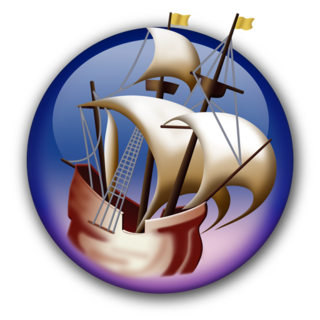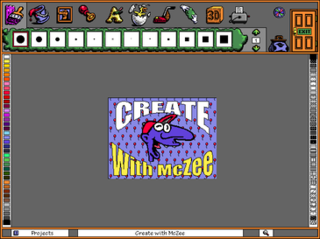
Microsoft Word is a word processor developed by Microsoft. It was first released on October 25, 1983, under the name Multi-Tool Word for Xenix systems. Subsequent versions were later written for several other platforms including: IBM PCs running DOS (1983), Apple Macintosh running the Classic Mac OS (1985), AT&T UNIX PC (1985), Atari ST (1988), OS/2 (1989), Microsoft Windows (1989), SCO Unix (1990), macOS (2001), Web browsers (2010), iOS (2014) and Android (2015). Using Wine, versions of Microsoft Word before 2013 can be run on Linux.

WordStar is a word processor application for microcomputers. It was published by MicroPro International and originally written for the CP/M-80 operating system, with later editions added for MS-DOS and other 16-bit PC OSes. Rob Barnaby was the sole author of the early versions of the program.
In human–computer interaction and user interface design, cut, copy, and paste are related commands that offer an interprocess communication technique for transferring data through a computer's user interface. The cut command removes the selected data from its original position, while the copy command creates a duplicate; in both cases the selected data is kept in temporary storage. The data from the clipboard is later inserted wherever a paste command is issued. The data remains available to any application supporting the feature, thus allowing easy data transfer between applications.
FileMaker is a cross-platform relational database application from Claris International, a subsidiary of Apple Inc. It integrates a database engine with a graphical user interface (GUI) and security features, allowing users to modify a database by dragging new elements into layouts, screens, or forms. It is available in desktop, server, iOS and web-delivery configurations.

3D Movie Maker is a children's computer program developed by Microsoft Home's Microsoft Kids subsidiary released in 1995. Using the program, users can make films by placing 3D characters and props into pre-rendered environments, as well as adding actions, sound effects, music, text, speech and special effects. Movies are then saved in the .3mm file format.

OmniGraffle is a diagramming and digital illustration application for macOS and iOS created by The Omni Group.

NeoOffice is an office suite for the macOS operating system developed by Planamesa Inc. It is a commercial fork of the free and open source LibreOffice office suite, including a word processor, spreadsheet, presentation program and graphics program, it adds some features not present in the macOS versions of LibreOffice and Apache OpenOffice. Current versions are based on LibreOffice 4.4, which was released mid-2014.

iWork is an office suite of applications created by Apple for its macOS, iPadOS, and iOS operating systems, and also available cross-platform through the iCloud website.

Pages is a word processor developed by Apple Inc. It is part of the iWork productivity suite and runs on the macOS, iPadOS and iOS operating systems. It is also available on iCloud on the web. The first version of Pages was released in February 2005. Pages is marketed by Apple as an easy-to-use application that allows users to quickly create documents on their devices. A number of Apple-designed templates comprising different themes are included with Pages.
Nisus Writer, originally Nisus, is a word processing program for the Apple Macintosh. The program is available in two varieties: Nisus Writer Express, and Nisus Writer Pro.

Kid Pix is a bitmap drawing program designed for children. Originally created by Craig Hickman, it was first released for the Macintosh in 1989 and subsequently published in 1991 by Broderbund. Hickman was inspired to create Kid Pix after watching his son Ben struggle with MacPaint, and thus the main idea behind its development was to create a drawing program that would be very simple to use.

Microsoft Office 2007 is an office suite for Windows, developed and published by Microsoft. It was officially revealed on March 9, 2006 and was the 12th version of Microsoft Office. It was released to manufacturing on November 3, 2006; it was subsequently made available to volume license customers on November 30, 2006, and later to retail on January 30, 2007, shortly after the completion of Windows Vista. The ninth major release of Office for Windows, Office 2007 was preceded by Office 2003 and succeeded by Office 2010. The Mac OS X equivalent, Microsoft Office 2008 for Mac, was released on January 15, 2008.

File Manager is a file manager program bundled with releases of OS/2 and Microsoft Windows between 1988 and 1999 and available from 6 April 2018 as an optional download for all modern releases of Windows, including Windows 10.

Microsoft Office 2001 is a suite of productivity software for Mac OS 8, Mac OS 9, or the Classic environment in Mac OS X. It is the Mac equivalent of Office 2000. It was developed by Microsoft and announced on September 13, 2000 before its release on October 11, 2000.

Fine Artist is a raster graphics editor program created by Microsoft Kids in 1993. Using this program, it is possible to create paintings. The interface and environment is especially targeted towards children and is set in Imaginopolis with the main helper being a character known as McZee. Fine Artist was announced by Microsoft on 7 December 1993 and was released in 1994. It ran on both MS-DOS 3.2 and the Windows 3.1 operating system. A version for Apple Macintosh was also released. Fine Artist is discontinued, but can still be acquired from online stores and auction websites such as eBay.

In computing, the trash is a graphical user interface desktop metaphor for temporary storage for files set aside by the user for deletion, but not yet permanently erased. The concept and name is part of Mac operating systems, a similar implementation is called the Recycle Bin in Microsoft Windows, and other operating systems use other names.

Creative Writer 2, known as Mon Atelier d'Écriture in French and Junior Schreibstudio in German, was a word processing program released in 1996 by Microsoft Kids. The interface was updated and the program was now designed for Windows 95.

The first version of Microsoft Word was developed by Charles Simonyi and Richard Brodie, former Xerox programmers hired by Bill Gates and Paul Allen in 1981. Both programmers worked on Xerox Bravo, the first WYSIWYG word processor. The first Word version, Word 1.0, was released in October 1983 for Xenix and MS-DOS; it was followed by four very similar versions that were not very successful. The first Windows version was released in 1989, with a slightly improved interface. When Windows 3.0 was released in 1990, Word became a huge commercial success. Word for Windows 1.0 was followed by Word 2.0 in 1991 and Word 6.0 in 1993. Then it was renamed to Word 95 and Word 97, Word 2000 and Word for Office XP. With the release of Word 2003, the numbering was again year-based. Since then, Windows versions include Word 2007, Word 2010, Word 2013, Word 2016, and most recently, Word for Office 365.
Microsoft Office shared tools are software components that are included in all Microsoft Office products.

Microsoft Office 2016 is a version of the Microsoft Office productivity suite, succeeding both Office 2013 and Office for Mac 2011 and preceding Office 2019, which in turn was succeeded by Office 2021 for both platforms. It was released on macOS on July 9, 2015, and on Microsoft Windows on September 22, 2015, for Office 365 subscribers. Mainstream support ended on October 13, 2020, and extended support for most editions of Office 2016 will end on October 14, 2025, the same day as Windows 10. The perpetually licensed version on macOS and Windows was released on September 22, 2015. Office 2016 requires Windows 7 SP1, Windows Server 2008 R2 SP1 or OS X Yosemite at the minimum. It is the last version of Microsoft Office to support Windows 7 SP1, Windows Server 2008 R2 SP1, Windows 8, Windows Server 2012, Windows 8.1, Windows Server 2012 R2, Windows 10 RTM–1803 and Windows Server 2016; as the following version, Microsoft Office 2019 only supports Windows 10 version 1809, Windows Server 2019 or later.













